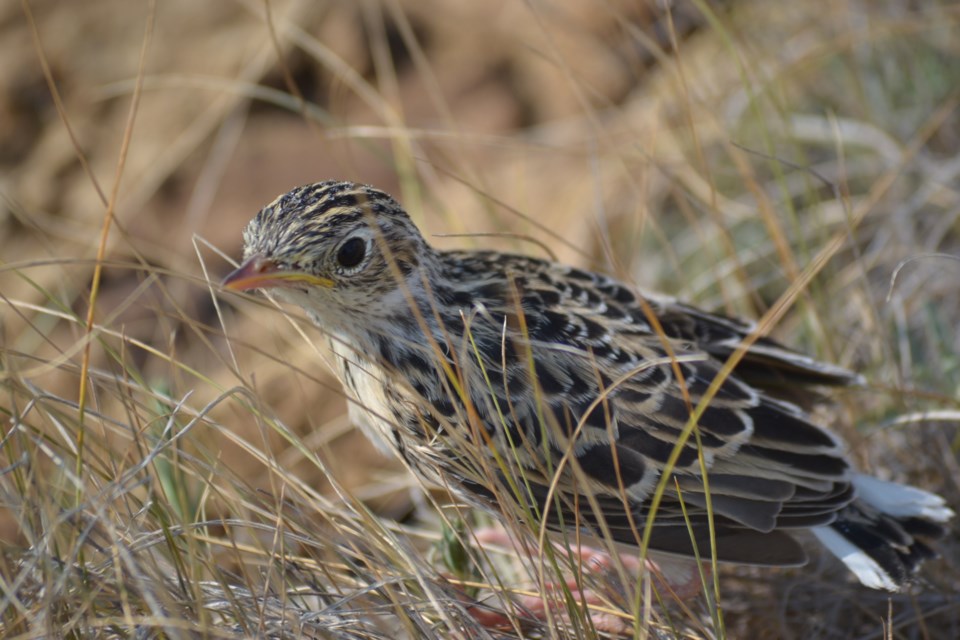A hard-to-spot grassland bird will be one of the focuses of the Glenbow Ranch Park Foundation's (GRPF) conservation efforts this year.
The Sprague's pipit is a medium-sized bird that can occasionally be spotted in the sprawling provincial park located in west Rocky View County. It is considered a threatened species, due to the loss of native grasslands – the bird's natural habitat – in Canada over the years.
Michelle Delorme, the recently hired executive director for GRPF (the non-profit group that monitors and maintains Glenbow Ranch Provincial Park) said the foundation's staff will be restoring some of the areas within the park in which the Sprague's pipit tends to nest.
As well, she said the foundation intends to do some data collection throughout 2023, such as counting how many Sprague's pipits there are in the park and mapping exaclty where in the park the birds tend to most often be found.
“We know there are a few different areas of the park they live in, and they are a grassland bird that is threatened within Canada,” Delorme said. “We want to make sure our grasslands remain healthy for the Sprague’s pipit to continue nesting at.”
According to the website allaboutbirds.org, the Sprague's pipit is an unassuming song bird with “a plain buffy plumage.” But while the bird is fairly inconspicuous, the Sprague's pipit “possesses an amazing song flight, hovering on rapidly fluttering wings high above its territory, singing a lovely, downward-swirling song during bursts of gliding.”
Delorme noted it's not common for birders to see them when trekking through Glenbow Ranch Provincial Park, as the Sprague's pipit tends to blend in with the grass.
“We’re not telling people where those areas are because we don’t want them to become a hot spot for people to be disturbing them,” she said.
Because the Sprague's pipit is sensitive to any kind of human interference, the species' population has been in decline for many decades. Blake Weis, the conservation coordinator at GRPF, said a report that came out last year called 'The State of the Birds' found the population of the Sprague's pipit has declined 50 per cent in North America since 1970, and is projected to see another 50 per cent drop in the next five decades if nothing is done.
“Sprague’s pipits, they’ve been identified as what they call a ‘tipping point’ species,” Weis explained.
While Sprague's pipits can be found throughout the prairie provinces, Weis said Glenbow Ranch Provincial Park is close to the western edge of the bird's range. He said they're more common as you head east.
“Historically, they would have been much more common here,” Weis said, adding that as the population of a species declines, their range tends to shrink inwards.
“Since we’re near the edge, the populations here likely would have been much higher in the past, before people started doing things like cultivating fields, building roads and cities and all that stuff. They require a large area of grassland habitat without a lot of trees, shrubs, and not any man-made anything.”
Throughout 2023, GRPF will be raising money to support the foundation's data collection and restoration of the Sprague's pipit's habitat within the park. The foundation encourages people to donate to the cause, as well as participate in the physical removal of certain non-native invasive species that can hinder the bird's environment later this year.
“The other part of what we’re planning on doing is putting some bio-acoustics into the park so we can capture and hear the Sprague’s pipit as well,” Delorme said. “It’s part of our data collection to see how they’re doing, improving the population, and just making sure it’s an overall healthier environment for them to continue thriving in.
“We’ll be doing a reach-out for volunteers to help us with that project once we get going with it and once they’re done all their nesting and it’s safe to go into their habitat areas. That’s why we’re fundraising for the project itself – it’s a manual process.”
For more information on GRPF's conservation efforts or how to assist the foundation in their protection of the Sprague's pipit, visit grpf.ca




